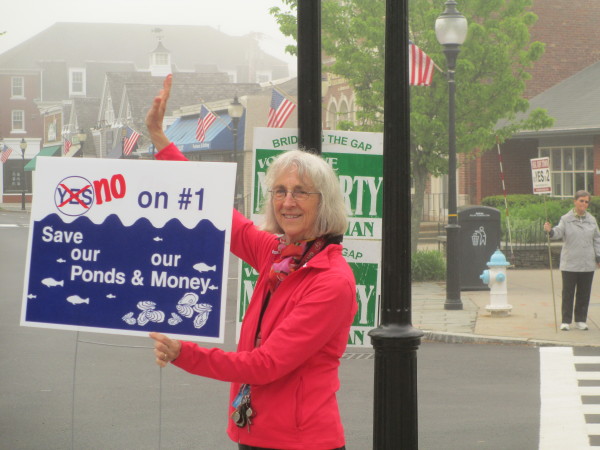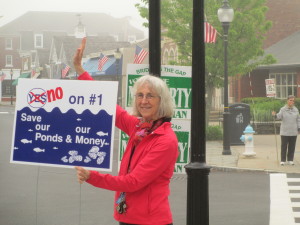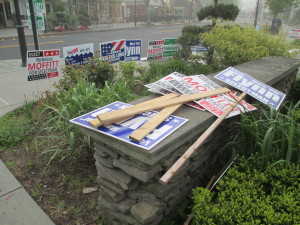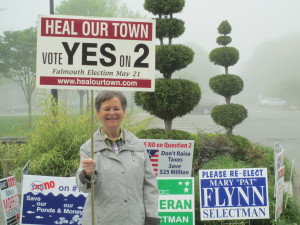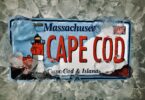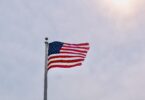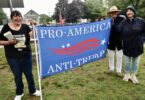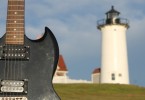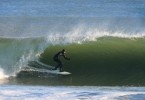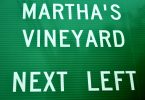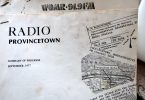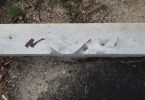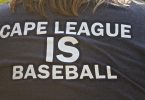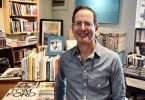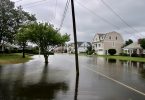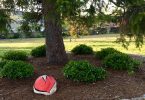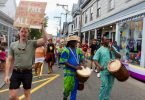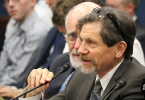FALMOUTH – The signs were clear. Vote “yes.” And vote “no.” But it was a foggy election morning at the polling place that is Falmouth Town Hall.
At 6:45 this election morning, Christine Rawley showed up and stuck her signs, “No on 2”, into the ground next to all the other electioneering placards at the entrance to the polling place.
“Signs are important,” she said. “I think people learn in many different ways. Some people learn by visuals.” The idea of signs is a reinforcement through the election season, finishing at the polling places, she said. “As people get used to seeing the visuals, they relate,” she said.
Rawley, who has held signs in the past but was only planting signs today, said the proper strategy is, “You always want to be reaching out. Hold the hand with one sign, wave with the other, and make eye contact.”
Eye contact. Every sign holder that later showed up for duty on this election morning talked about that holy grail of campaigning. There is one brief moment of recognition that every sign holder hopes for from the driver heading in to vote.
Linda “Lin” Whitehead was the first actual sign holder to show up. Whitehead said her strategy is to “Stand here and wave and if you see people you know, say hello. It’s fun to see people you know in this town because it is such a great town.”
Signs make a difference, said Whitehead, because, “I’ve noticed that a lot of people still have not read up on these issues.” Will a sign work? “It might because some people are still unsure and maybe one little thing will trigger their mind and they will say, oh yeah.”
Hilda Maingay, who held a sign that said “No on 1,” said her strategy is to “wear bright clothes. I have pink on.” She added, “I have a good time. And if a person recognizes me and they think, Oh, I know what she’s for, maybe they will vote the right way.”
Whitehead was there with a “Yes on Question 2” sign, which carried the slogan “Heal our Town.”
The slogan, part of a campaign to remove Falmouth’s two municipal wind turbines, was dreamt up by a public relations person from the Berkshires, said Malcolm Donald, who also showed up to hold the same sign. The original sign said “Too big, Too close, Heal our town,” but that was too many words for a sign, explained Donald.
Donald said he held his very first campaign sign at 8 years old, campaigning with his mother, for Richard Nixon for president in 1960. When Nixon lost, Donald wrote the candidate and Nixon wrote Donald back, signed the letter, and sent a photograph of his family. This year, he was holding a sign about an issue far more personal. “I am 1,250 feet from the turbines,” he said.
Do signs help a person decide how to vote? Rawley said, “I think that a lot of people are still confused. They are especially confused by the ballot questions.” She said signs matter because everything matters in campaigns. And standing with others holding signs is a “wonderful display of democracy.”
Maingay also said that many voters were confused about the issues and she believed a final reminder before voting may help sway minds.
Judy Fenwick stood holding a blue and white Pat Flynn for Selectman sign and explained, “I know more about campaign signs than you ever want to know.” The sign she held, she said, was made by the Drummer Boy Company. They were good, she said, but they are no longer in business. Many signs now are ordered from a template on the Internet, where the candidate simply puts a name in a pre-made design. Plus, there are local sign companies.
Newer sign styles of a thin unstable metal began appearing in the last presidential election, she said. Corrugated cardboard is best because it doesn’t bend in the wind. As she talked early in what would surely be a long day, she noted, “I’m going to be all over the place because I’ve had too much caffeine.”
She explained that signs are easy to design for a candidate. Just make the name dominate the sign. Ballot issues are more difficult because they have to get across an idea in just a few words, said Fenwick.
Colors also matter, she said. “People try to establish territory with colors,” she said, pointing out that maroon signs aligns candidates with the Falmouth High School colors and therefore conveys a certain hometown message. “Red white and blue is also popular,” she said.
“Campaigns have sign lists,” said Fenwick. “They are carefully built. These are properties where the owners allow a sign.” A well-cultivated list is valuable and she said can be passed from candidate to candidate.
Fenwick also explained that there are three good corners in town for signs before election day – the three busiest traffic lights in Falmouth; Stop & Shop lights, Falmouth Hospital lights, and Davisville corner.
Many campaigns have moved towards electronic advertising and social media, but Fenwick said of signs, “These are the ‘books’ of the campaign. They have a simple message, they are tactile, and they are visually appealing.”
As for holding a sign, “I wouldn’t be out here if it wasn’t fun.” said Fenwick.
Rebecca Moffitt, a candidate for selectman, stood holding her red, white and black sign. Someone on her election committee picked the colors, said Moffitt. “I had something purple but (people in her campaign) were saying it looked like Easter eggs.”
“I think signs are absolutely important. It announces to people that something is happening. “if you want to sell a house, you have a sign. If you have a birthday party, you have a sign,” she said.
Moffitt said the number of signs is not an indication of who is going to win, but she said that voters notice the location of signs, especially those that are placed illegally on town property.
“I am the best sign holder,” said Moffitt. “I go out early in the morning. I love holding signs.”
Rich Latimer, a longtime vocal town meeting member, showed up in front of town hall briefly and stuck some “Vote yes on 18” signs in the ground. Signs? “I don’t think they make a huge difference,” he said. Are the number of signs an indicator of who might win? “They are an indicator of who has money to spend,” he said.
Julia Taylor, Falmouth representative on the Barnstable County Assembly of Delegates, is a veteran of campaigns and she with a “Flynn” for Selectman sign, endorsing the candidacy of Pat Flynn. Signs are important, she said, because, “I think you need to show you are serious and that you spent some money.”
Voters consider, “What are the other signs in the yard? What is the constellation of signs?,” said Taylor.
As for standing at the polling places, she said it makes some difference, but “it’s more showing the flag.”
Having held signs for many years, Fenwick knows how to handle most situations. “If I get the middle finger, I give a thumbs up. I call it re-engaging another digit.” All in all, she said, “People in town are pretty civil.”
But signs can cause controversies. “There is a big story behind this sign,” said Maingay. Essentially, her sign has a circle with a diagonal line through it over “Yes on 1” And then next to it is “No on 1” Maingay explained said her graphics, which she uses on stationary for many issues, was taken by her opponents, so she took it back. As Maingay explained it, both sides of Issue 1 have essentially the same sign. It was, indeed, a foggy morning.
– Brian Tarcy

